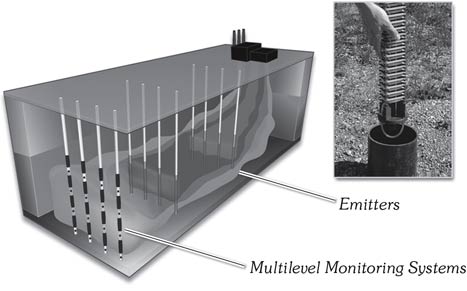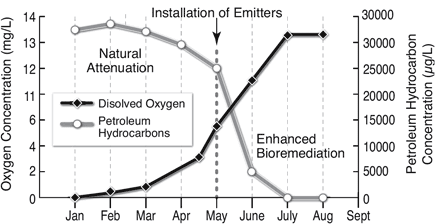Solinst Technical Bulletin |
Download |
Leaking Underground Storage Tanks
Over 482,000 sites across the United States have been identified as contaminated due to leaking underground storage tanks (LUST), according to the U.S. EPA web site. Many old fuel storage tanks have corroded and rusted with time, released their contents, and polluted groundwater with MTBE, BTEX and other petroleum hydrocarbons.
The EPA’s federal underground storage tank (UST) regulations have been in place for over ten years now, and 380,000 of these contaminated sites have been successfully cleaned up. Yet, with thousands of tainted sites remaining and future spills and leaks inevitable, the environment and our drinking water remain at risk.
Enhanced Bioremediation
The nature of remedial approaches for LUST sites has significantly evolved over the years. Monitoring natural attenuation is now often the first choice, if not the only choice for LUST site remediation. However, techniques that enhance natural attenuation processes are commonly being used due to their potential to speed up remedial programs.
Waterloo Emitters
The Waterloo Emitter™ is a simple, low cost remedial device designed to enhance the natural biodegradation of petroleum hydrocarbons in groundwater. The Emitter allows the controlled release of oxygen into impacted groundwater, thus creating the ideal conditions to stimulate aerobic biodegradation.
The Waterloo Emitter provides remediation engineers with numerous benefits including:
- Enhancing a naturally occurring process
- Elimination of contaminants in place
- No harmful by-products produced
- Simple installation, operation and monitoring requirements
- Minimal site disturbance
- No electricity required
- Low cost


Installing Waterloo Emitters increases dissolved oxygen concentrations and enhances biodegradation
The Technology
Designed to install easily in 2", 4" or 6" wells, the Waterloo Emitter simply consists of silicone or polyethylene tubing coiled around a PVC frame. Single or multiple Emitters can be placed in screened wells or open boreholes, spanning the contaminant plume thickness.
The technology is based on diffusion principles whereby a concentration gradient is set up between the inside of the Waterloo Emitter tubing and the groundwater. The transfer of oxygen takes place on a molecular level, providing a steady, regulated supply that is critical to the proper growth and maintenance of the natural in-situ microbial population.
Since groundwater flow around the Emitter is continuous oxygen, equilibrium is never reached between the tubing and the groundwater. This results in a steady diffusion of oxygen into the groundwater with no decrease in concentration due to bubbling.
Summary
At suitable LUST sites, in-situ groundwater bioremediation techniques have the ability to make clean-up faster, more effective, and less expensive.
The Waterloo Emitter provides remediation professionals with a reliable, low cost device, which can be used on its own, or as part of a multi-phase approach to attenuate petroleum contamination in groundwater. The simple use of oxygen allows the Emitter to enhance naturally occurring aerobic biodegradation.
Detailed groundwater monitoring at LUST sites can be provided by Solinst Waterloo and CMT® Multilevel Systems. They monitor multiple depth-discrete zones in a single borehole. Transects of installations offer a more precise estimate of contamination across a site, and the ability to track the attenuation process.



